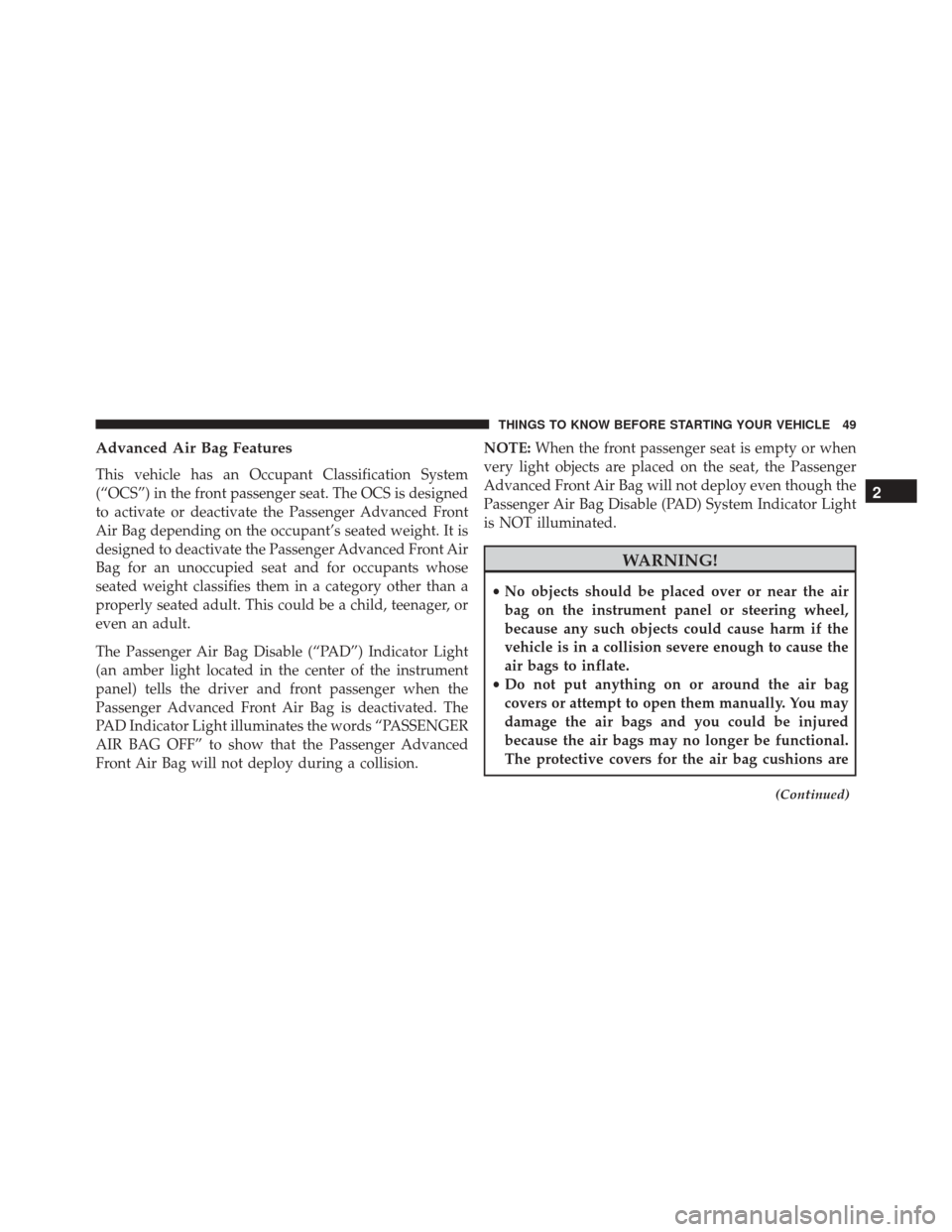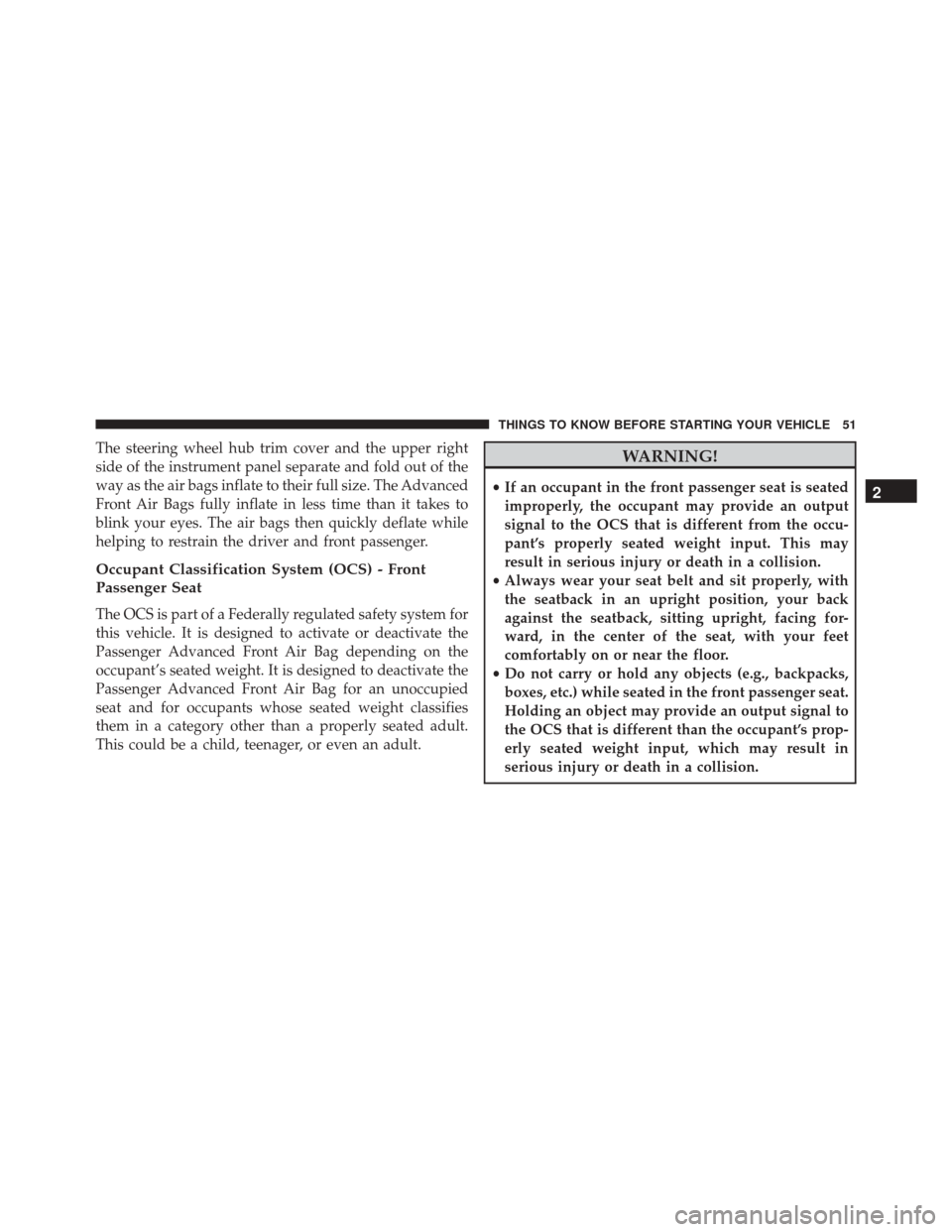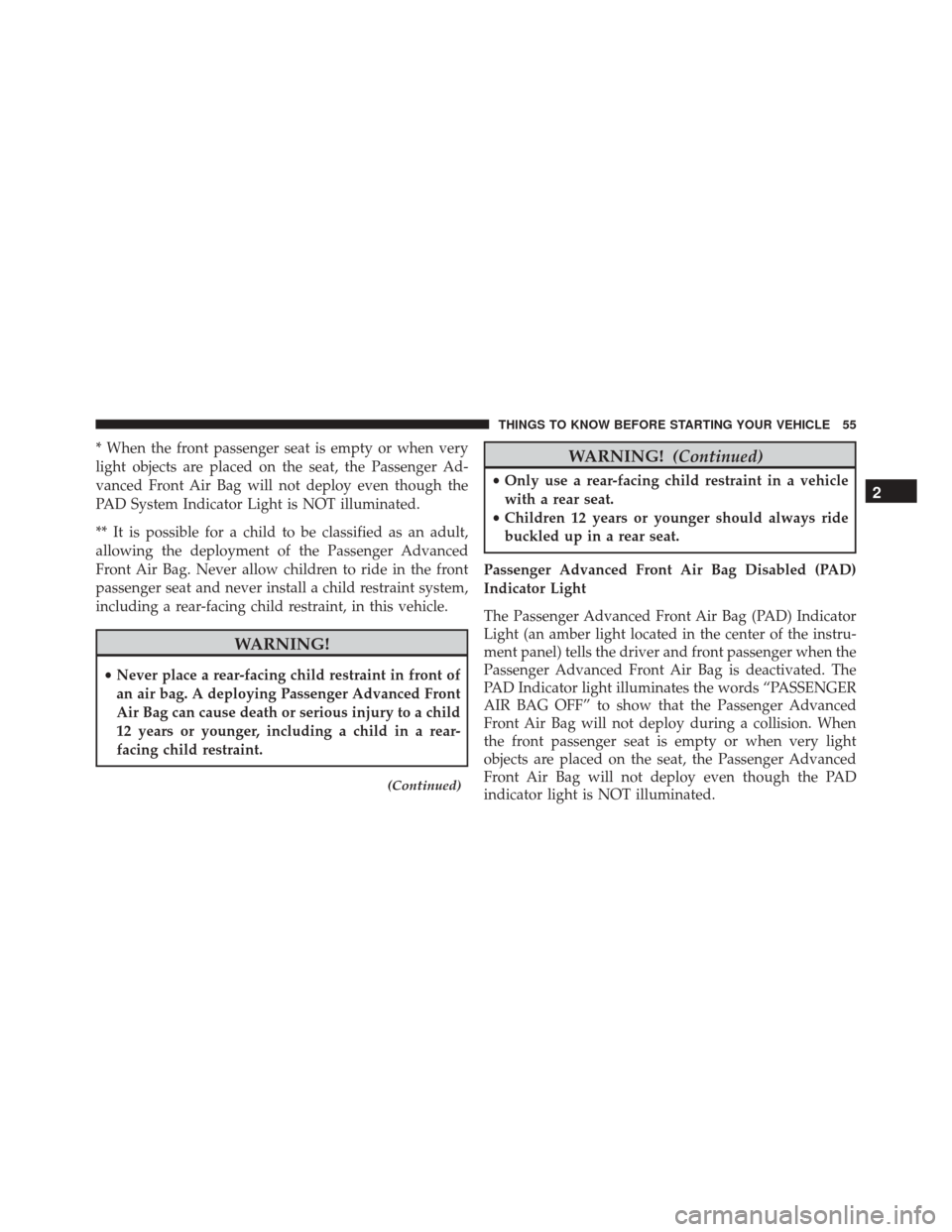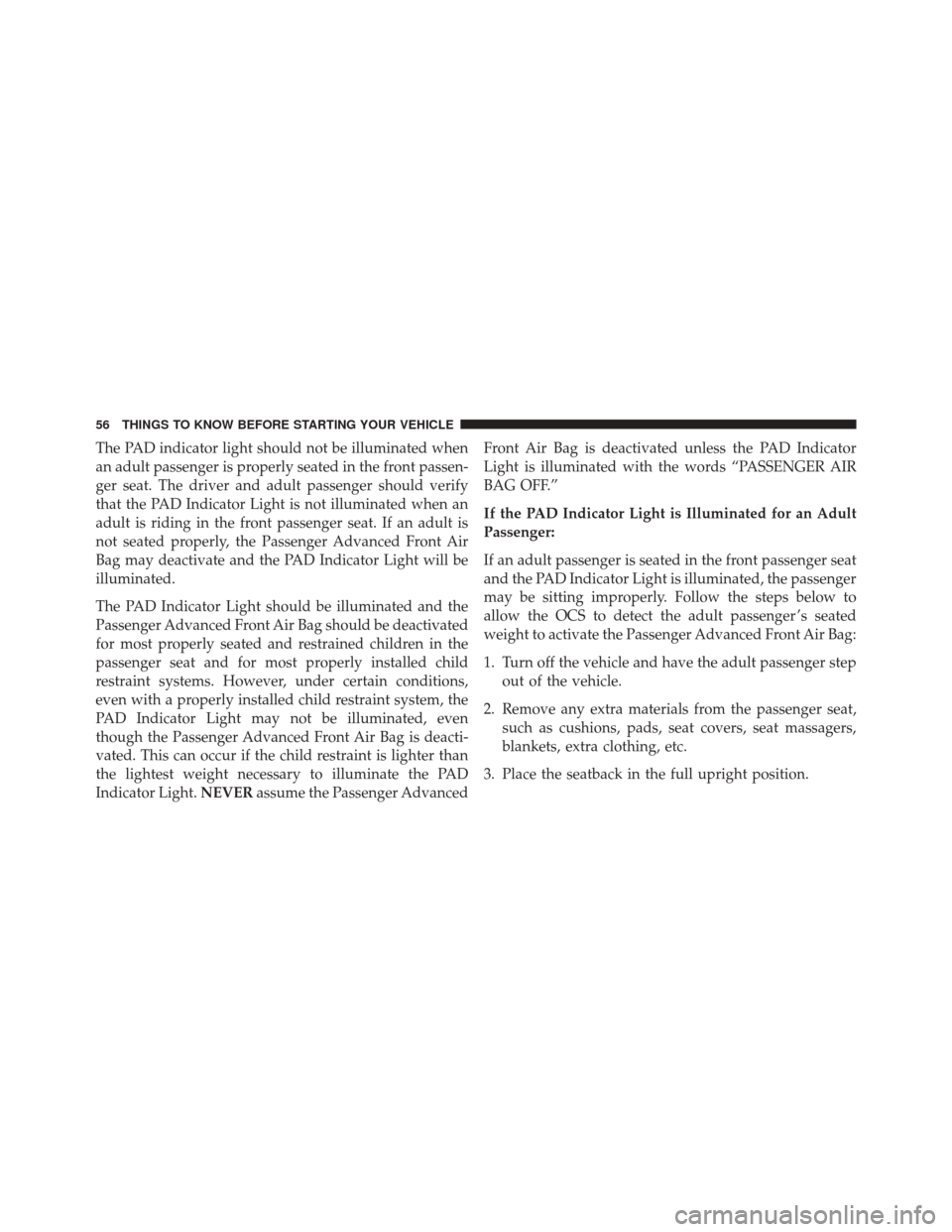Page 51 of 423

Advanced Air Bag Features
This vehicle has an Occupant Classification System
(“OCS”) in the front passenger seat. The OCS is designed
to activate or deactivate the Passenger Advanced Front
Air Bag depending on the occupant’s seated weight. It is
designed to deactivate the Passenger Advanced Front Air
Bag for an unoccupied seat and for occupants whose
seated weight classifies them in a category other than a
properly seated adult. This could be a child, teenager, or
even an adult.
The Passenger Air Bag Disable (“PAD”) Indicator Light
(an amber light located in the center of the instrument
panel) tells the driver and front passenger when the
Passenger Advanced Front Air Bag is deactivated. The
PAD Indicator Light illuminates the words “PASSENGER
AIR BAG OFF” to show that the Passenger Advanced
Front Air Bag will not deploy during a collision.NOTE:
When the front passenger seat is empty or when
very light objects are placed on the seat, the Passenger
Advanced Front Air Bag will not deploy even though the
Passenger Air Bag Disable (PAD) System Indicator Light
is NOT illuminated.
WARNING!
• No objects should be placed over or near the air
bag on the instrument panel or steering wheel,
because any such objects could cause harm if the
vehicle is in a collision severe enough to cause the
air bags to inflate.
• Do not put anything on or around the air bag
covers or attempt to open them manually. You may
damage the air bags and you could be injured
because the air bags may no longer be functional.
The protective covers for the air bag cushions are
(Continued)
2
THINGS TO KNOW BEFORE STARTING YOUR VEHICLE 49
Page 53 of 423

The steering wheel hub trim cover and the upper right
side of the instrument panel separate and fold out of the
way as the air bags inflate to their full size. The Advanced
Front Air Bags fully inflate in less time than it takes to
blink your eyes. The air bags then quickly deflate while
helping to restrain the driver and front passenger.
Occupant Classification System (OCS) - Front
Passenger Seat
The OCS is part of a Federally regulated safety system for
this vehicle. It is designed to activate or deactivate the
Passenger Advanced Front Air Bag depending on the
occupant’s seated weight. It is designed to deactivate the
Passenger Advanced Front Air Bag for an unoccupied
seat and for occupants whose seated weight classifies
them in a category other than a properly seated adult.
This could be a child, teenager, or even an adult.
WARNING!
•If an occupant in the front passenger seat is seated
improperly, the occupant may provide an output
signal to the OCS that is different from the occu-
pant’s properly seated weight input. This may
result in serious injury or death in a collision.
• Always wear your seat belt and sit properly, with
the seatback in an upright position, your back
against the seatback, sitting upright, facing for-
ward, in the center of the seat, with your feet
comfortably on or near the floor.
• Do not carry or hold any objects (e.g., backpacks,
boxes, etc.) while seated in the front passenger seat.
Holding an object may provide an output signal to
the OCS that is different than the occupant’s prop-
erly seated weight input, which may result in
serious injury or death in a collision.2
THINGS TO KNOW BEFORE STARTING YOUR VEHICLE 51
Page 55 of 423
•Sitting with their back against the seat back and the
seat back in an upright position The OCS may deactivate the deployment of the Passen-
ger Advanced Front Air Bag if the OCS estimates that:
•
The front passenger seat is unoccupied or has very
light objects in it.
• The front passenger seat is occupied by a rear-facing
child restraint.
• The front passenger seat is occupied by a child,
including a child seated in a forward-facing child
restraint or booster seat.
• The front passenger seat is occupied by a small pas-
senger, including a child or small adult.
• The front passenger is not properly seated or his or her
weight is taken off of the seat for a period of time.
Seated Properly
2
THINGS TO KNOW BEFORE STARTING YOUR VEHICLE 53
Page 56 of 423
Passenger Air Bag Disable (PAD) System
Front Passenger
Seat Occupant
StatusFront Passen-
ger Advanced
Air Bag Dis-
abled Indicator
Light (“PAD”)
StatusFront Passenger
Air Bag Status
Unoccupied
seat * NOT ILLUMI-
NATEDDEACTIVATED
Grocery bags,
heavy brief-
cases, and other
relatively light
objects “PASSENGER
AIR BAG OFF”
DEACTIVATED
Rearward facing
infant seat** “PASSENGER
AIR BAG OFF”DEACTIVATED
Front Passenger
Seat Occupant
Status Front Passen-
ger Advanced
Air Bag Dis-
abled Indicator
Light (“PAD”)
StatusFront Passenger
Air Bag Status
Child, including
a child seated in
a forward-
facing child re-
straint or
booster seat** “PASSENGER
AIR BAG OFF”
DEACTIVATED
Small adult “PASSENGER AIR BAG OFF”DEACTIVATED
Properly seated
adult NOT ILLUMI-
NATEDACTIVATED
54 THINGS TO KNOW BEFORE STARTING YOUR VEHICLE
Page 57 of 423

* When the front passenger seat is empty or when very
light objects are placed on the seat, the Passenger Ad-
vanced Front Air Bag will not deploy even though the
PAD System Indicator Light is NOT illuminated.
** It is possible for a child to be classified as an adult,
allowing the deployment of the Passenger Advanced
Front Air Bag. Never allow children to ride in the front
passenger seat and never install a child restraint system,
including a rear-facing child restraint, in this vehicle.
WARNING!
•Never place a rear-facing child restraint in front of
an air bag. A deploying Passenger Advanced Front
Air Bag can cause death or serious injury to a child
12 years or younger, including a child in a rear-
facing child restraint.
(Continued)
WARNING! (Continued)
•Only use a rear-facing child restraint in a vehicle
with a rear seat.
• Children 12 years or younger should always ride
buckled up in a rear seat.
Passenger Advanced Front Air Bag Disabled (PAD)
Indicator Light
The Passenger Advanced Front Air Bag (PAD) Indicator
Light (an amber light located in the center of the instru-
ment panel) tells the driver and front passenger when the
Passenger Advanced Front Air Bag is deactivated. The
PAD Indicator light illuminates the words “PASSENGER
AIR BAG OFF” to show that the Passenger Advanced
Front Air Bag will not deploy during a collision. When
the front passenger seat is empty or when very light
objects are placed on the seat, the Passenger Advanced
Front Air Bag will not deploy even though the PAD
indicator light is NOT illuminated.2
THINGS TO KNOW BEFORE STARTING YOUR VEHICLE 55
Page 58 of 423

The PAD indicator light should not be illuminated when
an adult passenger is properly seated in the front passen-
ger seat. The driver and adult passenger should verify
that the PAD Indicator Light is not illuminated when an
adult is riding in the front passenger seat. If an adult is
not seated properly, the Passenger Advanced Front Air
Bag may deactivate and the PAD Indicator Light will be
illuminated.
The PAD Indicator Light should be illuminated and the
Passenger Advanced Front Air Bag should be deactivated
for most properly seated and restrained children in the
passenger seat and for most properly installed child
restraint systems. However, under certain conditions,
even with a properly installed child restraint system, the
PAD Indicator Light may not be illuminated, even
though the Passenger Advanced Front Air Bag is deacti-
vated. This can occur if the child restraint is lighter than
the lightest weight necessary to illuminate the PAD
Indicator Light.NEVERassume the Passenger Advanced Front Air Bag is deactivated unless the PAD Indicator
Light is illuminated with the words “PASSENGER AIR
BAG OFF.”
If the PAD Indicator Light is Illuminated for an Adult
Passenger:
If an adult passenger is seated in the front passenger seat
and the PAD Indicator Light is illuminated, the passenger
may be sitting improperly. Follow the steps below to
allow the OCS to detect the adult passenger ’s seated
weight to activate the Passenger Advanced Front Air Bag:
1. Turn off the vehicle and have the adult passenger step
out of the vehicle.
2. Remove any extra materials from the passenger seat, such as cushions, pads, seat covers, seat massagers,
blankets, extra clothing, etc.
3. Place the seatback in the full upright position.
56 THINGS TO KNOW BEFORE STARTING YOUR VEHICLE
Page 59 of 423

4. Have the adult passenger sit in the center of the seat,with the passenger ’s feet comfortably on or near the
floor, and with their back against the seatback.
5. Restart the vehicle and have the passenger remain in this seated position for two to three minutes after
restarting the vehicle.
WARNING!
If the PAD Indicator Light remains illuminated for
an adult passenger, have an authorized dealer service
the air bag system immediately. Failure to do so may
cause serious injury or death. If the PAD Indicator
Light is illuminated with the words “PASSENGER
AIR BAG OFF” the Passenger Advanced Front Air
Bag will not inflate in the event of a collision.
WARNING!
•Never place a rear-facing child restraint in front of
an air bag. A deploying Passenger Advanced Front
Air Bag can cause death or serious injury to a child
12 years or younger, including a child in a rear-
facing child restraint.
• Only use a rear-facing child restraint in a vehicle
with a rear seat.
• Children 12 years or younger should always ride
buckled up in a rear seat.
Lighter Weight Passengers (Including Small Adults)
When a lighter weight passenger, including a small adult
occupies the passenger seat, the Passenger Advanced
Front Air Bag may be deactivated. Therefore, the Passen-
ger Advanced Front Air Bag may or may not be activated
for a lighter weight passenger, including a small adult2
THINGS TO KNOW BEFORE STARTING YOUR VEHICLE 57
Page 66 of 423

addition to the injury reduction potential provided by the
seat belts and body structure. The SABICs are located in
the door trim below the side windows. The trim covering
the SABICs is labeled “SRS AIRBAG” or “AIRBAG.”The SABICs may help reduce the risk of partial or
complete ejection of vehicle occupants through side
windows in certain side impact events.
The SABICs deploy upward, covering the side windows.
An inflating SABIC pushes the outside edge of the trim
out of the way and covers the window. The SABICs
inflate with enough force to injure occupants if they are
not belted and seated properly, or if items are positioned
in the area where the SABICs inflate. Children are at an
even greater risk of injury from a deploying air bag.
SABICs are designed to activate in certain side impacts.
The Occupant Restraint Controller (“ORC”) determines
whether the deployment of the SABIC in a particular
impact event is appropriate, based on the severity and
type of collision. The side impact sensors aid the ORC in
determining the appropriate response to impact events.
The system is calibrated to deploy the SABIC on the
impact side of the vehicle during impacts that require
Supplemental Door-Integrated Side Air Bag Label
64 THINGS TO KNOW BEFORE STARTING YOUR VEHICLE